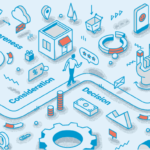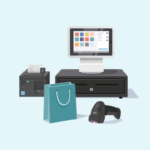One of the most effective ways to gauge your retail business’ health is by monitoring your returns. We’re not talking about returned merchandise (although you should keep an eye on that, too), but rather the number of returning customers. When it comes to business metrics, the strength of your customer retention is a key indicator of your success.
Yet, only 18 percent of retailers say they focus on retention. It comes down to human nature. When retailers want to increase sales, the first thing many turn to is ramping up new customer acquisition. But, while bringing new customers through the door is critical for growth, it shouldn’t be the only focus of your marketing. Putting equal effort into nurturing customer relationships so that people move from first-time buyers to repeat purchasers to loyal customers pays off big.
The return on returning customers
Research shows improving your customer retention rate by 5 percent drives an increase in profits by 25 to 95 percent. That’s because keeping a customer is typically much more cost-effective than attracting and converting a brand new one. Plus, once a prospective customer makes her first purchase from your store, the odds of generating additional sales are good. The success rate for making a sale to a new customer is 5 to 20 percent. With an existing customer, the success rate jumps to 60 to 70 percent.
Repeat customers also spend more. Returning customers are 50 percent more likely to try new products and spend 31 percent more than first-time buyers. Over the course of a year, you can count on existing customers to outspend new customers by 120 percent.
Equally valuable, happy customers will do some of your marketing for you. For retailers, customer loyalty translates into brand advocacy and referrals. Today, social media enables customers to reach even more prospects. When you deliver a differentiated in-store, online, and service experience, you can inspire customers to share the news with their social networks.
How to create many happy returns
Establishing a focused retention strategy starts with setting a goal. Experts recommend aiming to have 25 to 40 percent of sales coming from returning customers. Take a look at the data captured by your point-of-sale (POS) system to assess the current mix of new to returning customers. Then, set a course to build up the proportion of return purchasers by at least 5 percent per year.
Along with tracking the ratio of new and repeat customers, calculate the average lifetime customer value for your business. Multiply your average sale amount by the number of repeat sales and the average lifespan of your customers. Knowing the dollar value per customer over a lifetime – and how the number compares to your average customer acquisition costs – provides an important metric as you design and execute your retention strategies. Ideally, your customer lifetime value should be about three times your customer acquisition cost.
Nurture relationships one visit at a time
After a customer makes one purchase from you, there’s a 27 percent chance they’ll return for a second purchase. If you get them to make a second and third purchase, there’s a 54 percent chance they’ll make a fourth, putting them well on the road to loyalty. Create a follow-up strategy to incent them to come back. One way to do this is to send a personalized thank you and include a welcome gift, such as a coupon for their next purchase.
However, don’t overdo it on the promotional incentives. Find the balance between driving return visits through your customer experience so that you don’t create situations where customers wait for coupons. By tracking your acquisition and lifetime value numbers, you’ll ensure you offer discounts that are sustainable within the profit margins for your business.
Reward loyalty
A loyalty program is an important tool for engaging customers and strengthening their ties to your brand over time. Eight in ten customers say they’re more likely to make repeat purchases because of a store’s loyalty program. And half of consumers report spending more after signing up for a rewards program.
Get creative to build a program that’s unique to your business and reflects what matters to your target customers. Strong loyalty programs go beyond monetary perks to also include VIP access to exclusive events like sales or merchandise previews.
Related: Is Your Customer Loyalty Program Working Hard for Your Business?
Deliver memorable experiences
More than price, your interactions with a customer play a vital role in whether they’ll return. Sixty-six percent of shoppers say the buying experience matters more than price when it comes to making a purchase and inspiring loyalty.
Personalizing the experience can go a long way toward differentiating your business, without requiring a large marketing budget. Collect basic customer information through your POS and leverage it through strategic marketing. For example, send a handwritten thank-you note after a customer visit or send an email that suggests a complementary product based on a customer’s previous purchases. Customers respond. When retail experiences are personalized, customers are 110 percent more likely to make additional purchases.

Keep tracking
Increasing customer retention relies on tracking the details. Leverage your POS system to analyze your customer mix, track your progress through regular reporting, manage your loyalty program, and personalize customer experiences. Download our new guide, Data-driven Decisions: The Definitive Guide for Retailers, to explore how you can do more with data. And contact us for a demo to discover what’s possible with POSIM.











